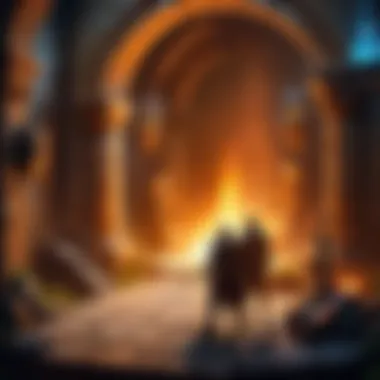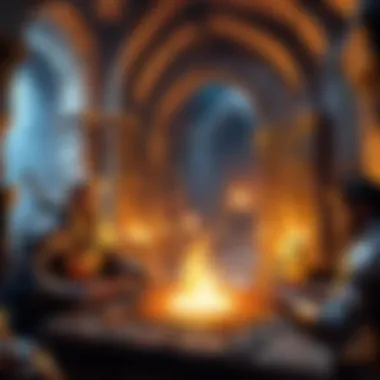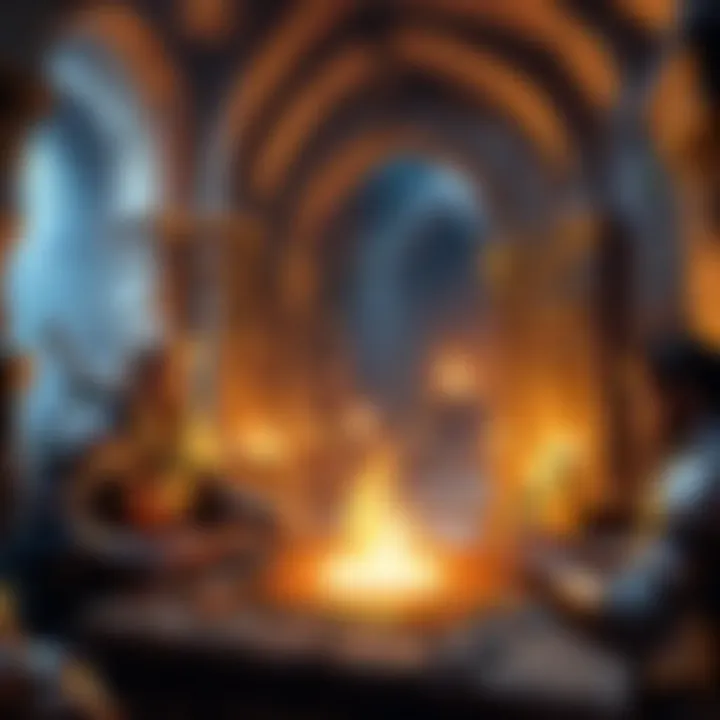Exploring Dungeon Mechanics in Magic: The Gathering


Intro
In the world of card games, few titles have managed to blend deep strategy with rich lore like Magic: The Gathering. Its innovative gameplay and constantly evolving mechanics have captivated players worldwide. Among these developments, the integration of dungeon mechanics has emerged as an intriguing facet of gameplay. This article aims to dissect this integration, exploring how dungeons intertwine with the conventional Magic framework, and the implications thereof for player experience and strategy.
Traditionally, dungeons have been the settings for epic quests in fantasy narratives; they hold treasures, threats, and countless surprises. Likewise, Magic: The Gathering has evolved with stories unfolding through its cards, connecting players to elaborate worlds. Notably, the advent of dungeon mechanics has allowed the game to merge these narratives directly into gameplay, augmenting the complexity and enriching the experience for both old hands and newcomers.
As we traverse through this guide, we will first discuss the historical context of dungeons in Magic: The Gathering, detailing the sets that introduced dungeon mechanics. We will further dissect how these elements enhance the narrative and strategic depth of the game. Player responses will be evaluated, illuminating the reception of these mechanics and their future potential. Through this lens, we seek to present an informed narrative for enthusiasts, bridging bygone eras with the evolving landscapes of gameplay.
Prelims to Dungeon Mechanics in Magic: The Gathering
The introduction of dungeon mechanics within Magic: The Gathering represents a notable evolution in gameplay that intertwines strategic depth with immersive storytelling. This section will delve into how these mechanics significantly impact player interactions, expand gameplay possibilities, and enhance the gaming experience. By exploring what dungeons bring to the table, we can understand why they have become crucial in the game's ongoing evolution.
Understanding the Basics
When players first think of dungeons, they might conjure up images of gothic castles and dark caverns filled with treasures and monsters. In the context of Magic: The Gathering, dungeon mechanics create a unique game aspect that invites players to traverse complex layouts while managing their resources. Basically, these mechanics can be seen as interactive experiences where each choice can lead to unexpected rewards or dire consequences. The core principle revolves around players undertaking adventures that guide them through intricate paths on a map, allowing them to uncover hidden secrets.
The mechanics typically involve specific cards designed to facilitate dungeon exploration. These cards often include effects that allow players to venture deeper into the dungeon, interact with various challenges, and secure rewards such as instant spells, creatures, or additional resources. By integrating dungeon mechanics, Magic: The Gathering emphasizes exploration and decision-making as essential components of gameplay, creating layers that enhance the overall experience.
Historical Context of Dungeon Prefaces
The concept of dungeons isn't new to Magic: The Gathering; however, their official introduction to the game came with the release of Adventures in the Forgotten Realms. This set draws heavily from Dungeons & Dragons, where dungeon crawling is a central theme. The collaboration represented an intersection of two rich fantasy realms that delight players for decades.
Historically, dungeon mechanics had been hinted at through various cards and sets, yet this was the first time they were implemented on such a scale. Players could navigate through dungeons in ways that made their choices impactful and meaningful, doing more than just playing cards. They engaged in a narrative, becoming adventurers themselves. With dungeons tied to the lore of Dungeons & Dragons, this feature not only enriched the narrative but also reignited interest in the Magic: The Gathering community.
"Dungeons transformed the way players experienced Magic: The Gathering, bridging lore and strategy in ways that had yet to be fully explored."
The response from the community proved to be overwhelmingly positive, as players found the mechanics to be a refreshing change that added depth without sacrificing gameplay simplicity. This section sets the stage for a deeper analysis of how dungeon mechanics function and their significance in the unfolding chapters of Magic: The Gathering.
Design Philosophy Behind Dungeon Mechanics
The design philosophy behind dungeon mechanics in Magic: The Gathering is a multifaceted endeavor aimed at enriching the player's experience. It hinges on several critical elements that fold into each other, creating a tapestry of engagement, strategy, and storytelling. At its core, the philosophical underpinning is built upon enhancing interaction through thematic depth and game mechanics.
Dungeon mechanics offer players an opportunity to narrate their own stories while exploring and battling through these fictional terrains. Unlike traditional mechanics, the dungeons serve as immersive settings that allow players to see their decks in play and how different paths can shape their strategies. This shift isn't just about moving pieces on a board; it’s about realizing one's adventure in a world where choices, encounters, and treasures intertwine.
Player Engagement and Narrative Depth
One of the pivotal aspects of dungeon mechanics is their power to heighten player engagement through narrative depth. With the introduction of dungeons, players step into a living story. They are no longer just card flippers; they become adventurers navigating through a series of choices that significantly impact their journey.
The mechanics operate on a layer of decision-making, where each step taken in a dungeon is charged with consequence. For instance, opting to explore a specific corridor may lead to either a hidden treasure or a deadly encounter. This takes strategy to a new level, as players must anticipate the potential risks or rewards before embarking on their exploration.
This narrative-driven approach also strengthens the emotional connection to the game. Players are likely to feel more invested in the outcomes—they celebrate victories with a sense of triumph and reflect on failures with thoughtful consideration. Being part of a narrative arc not only makes the game more memorable but also deepens player relationships with both the game and fellow competitors.
Balancing Complexity and Accessibility
While depth is important, the design philosophy must also account for balance—specifically, the delicate act of managing complexity and accessibility. Dungeon mechanics introduce several layers of interaction, which can be both a boon and a bane.
If the mechanics are too intricate, new players might be overwhelmed and deterred from engaging with the game. Conversely, if they are overly simplified, seasoned players might feel that the challenge has been stripped away. Therefore, the balance is crucial. The aim is to craft mechanics that appeal to both casual players wanting a straightforward game and hardcore enthusiasts looking for tactical nuances.
To achieve this balance, designers have developed accessible user interfaces and streamlined decision-making processes. For example, many dungeons provide clear in-game visuals that help players understand their choices without needing extensive prior knowledge of the mechanics. This facilitates a smoother entry for newcomers while still offering layers of complexity for veteran players to unravel and master.
The designers have also ensured that the learning curve is gradual. As players progress through the dungeons, they encounter increasingly intricate scenarios that naturally develop their understanding and prowess with the mechanics. This method fosters a sense of accomplishment, further enticing players to delve deeper into the Magic: The Gathering experience.


Ultimately, the design philosophy behind dungeon mechanics is about more than just game rules; it’s a nuanced approach designed to create a richer, more engaging experience. It invites players into a realm where narrative, strategy, and emotional investment intersect, fueling a more captivating gameplay journey.
"In the realm of gaming, it’s not merely about winning or losing; it’s about the stories we create and the worlds we inhabit together."
Ever since their inception, these mechanics have taken root within the fabric of the game, shaping not only how players interact with their decks but also with each other. This reflective depth is what helps maintain player loyalty and cultivates a thriving community.
Key Sets Featuring Dungeon Mechanics
The integration of dungeon mechanics into Magic: The Gathering has reshaped how players experience the game, and this shift is profoundly highlighted in various key sets. These sets serve not only as a rich wellspring of gameplay tactics but also as a canvas for storytelling, connecting narratives with choices on the battlefield. It's in these sets that players find unique dungeon-themed gameplay, with elements that accentuate strategy and engagement. In this section, we’ll discuss the pivotal role of key sets, particularly focusing on Adventures in the Forgotten Realms and the collaborative aspects stemming from Dungeons & Dragons.
Adventures in the Forgotten Realms
Adventures in the Forgotten Realms, released in July 2021, stands as a prime example of dungeon mechanics in action. This set was the first to weave Dungeons & Dragons lore directly into the tapestry of Magic: The Gathering, creating a crossroads of two beloved franchises. Here, dungeons are not mere add-ons; instead, they are intricately tied to the gameplay, offering players rich, immersive experiences.
In this set, players can embark on adventures through a series of dungeons, which are distinct pathways that players can explore while utilizing specific cards. The mechanics of venture into the dungeon allows players to progress through these locations, with each advancement triggering different effects and rewards that can shift the tide of a game. This mechanic not only adds variability to gameplay but also deepens player engagement by allowing them to mold their narrative paths mid-game.
Moreover, the dungeons in this set, such as the Lost Mine of Phandelver or Tomb of Annihilation, are embedded with thematic encounters that mirror classic tabletop experiences. By incorporating lore-driven elements like these, the set elevates Magic's narrative depth.
In essence, the Adventures in the Forgotten Realms set serves as a template encouraging players to appreciate strategy beyond mere card synergy by factoring in exploration and thematic progression.
The implications of Dungeons and Dragons Collaboration
The collaboration between Magic: The Gathering and Dungeons & Dragons isn’t just a marketing gimmick; it fundamentally alters how both games are perceived and played. This partnership symbolizes a merger of imagination and mechanics where both gaming universes can enhance each other's foundations. With the introduction of dungeon mechanics, players find themselves straddling two worlds that not only expand gameplay options but also engage their creativity.
Through this partnership, players can draw not only from Magic's legendary spells and creatures but also from D&D’s rich lore and diverse character backgrounds, granting depth to deck construction and gameplay strategies.
- Synergistic Choices: Players must now consider how their cards can effectively navigate through dungeon scenarios while building a deck that might also embody a backstory from D&D lore.
- Enhanced Player Experience: New players and veterans alike benefit from the rich narrative context, weaving traditional card play with adventure-like mechanics.
- Community Involvement: Fans of both franchises are encouraged to contribute through feedback forums, offering ideas that could shape future sets.
This melding of dungeons and card mechanics truly enriches Magic: The Gathering's gameplay, making it an enticing prospect for seasoned players and newcomers. As players traverse through dungeons, they not only engage with the mechanics but also with the very storytelling that has captivated audiences for decades.
"The adventure isn't just about the cards; it's about the journey through the dungeons that brings every game to life."
Overall, these sets signify an evolution in how Magic: The Gathering can approach gameplay—no longer solely focused on conflict, but open to adventure and storytelling that players can control, fostering an environment that goes beyond traditional card play.
Core Mechanics of Dungeon Play
Understanding the core mechanics of dungeon play within Magic: The Gathering is essential for grasping how this unique aspect reshapes gameplay and strategy. The allure of dungeons lies in the blend of exploration, progression, rewards, and challenges. These elements create a dynamic that often distinguishes a casual game from a deeply engaging experience. Dungeons demand not just skill in card play but also an understanding of how to navigate the intricate and often unpredictable pathways they present.
Exploration and Progression
Moving Through Dungeons
A cardinal aspect of moving through dungeons is how it embodies the essence of strategic exploration. In many ways, this is the heartbeat of dungeon mechanics. Players are often faced with choices that resemble those found in classic role-playing games, deciding which path to take leads to what kind of encounters. The thrill of discovery enhances the overall narrative where each decision can pivot the game toward victory or demise.
The unique characteristic of moving through dungeons is its focus on active engagement; players are not merely waiting for turns to pass but are continually involved in decision-making that impacts their journey.
Additionally, this mechanic offers substantial benefits. Engaging exploration often leads to a deeper narrative experience, encouraging players to craft their own stories amidst their quest.
However, it’s not all sunshine and roses. The decision-making process can also be a double-edged sword, as poor choices may result in unforeseen pitfalls, impacting not only one’s strategy but also overall enjoyment.
The Role of Map Accessibility
Map accessibility is another vital component of dungeon mechanics that shapes how players approach their game. This feature centers around how easily players can navigate the various options within a dungeon's layout. Effective map design encourages exploration yet maintains a sense of balance between challenge and reward. A well-charted path can either streamline one’s journey through the dungeon or complicate matters with twists and turns that require cognitive agility.
The key benefit here is offering strategic diversity. Players can decide whether to take risks by exploring deeper into the dungeon or whether to play it safe and seek established pathways for rewards.
One disadvantage that emerges from this mechanic may stem from potential frustrations; if map accessibility feels convoluted or overly complicated, players might become discouraged, detracting from the intended fun.
Rewards and Challenges
Encounters in Dungeons
Encounters in dungeons function as the pulse of gameplay, providing both risks and opportunities to players. They serve not only as obstacles but also as gateways to significant rewards, playing a major role in maintaining engagement throughout the course of the game. Each encounter can radically shift a player’s strategy, requiring them to adapt on the fly while maintaining their overarching goals.
Notably, encounters introduce a key characteristic: unpredictability. This element enhances replayability as no two dungeon explorations are typically the same, encouraging players to approach each game with fresh eyes.
However, while encounters can lead to thrilling moments, they can also introduce a level of frustration, particularly if luck isn't on a player's side. Navigating through unwanted encounters may induce stress rather than enjoyment.


Treasure and Consequences
Treasure and consequences form a juxtaposition vital to the thematic richness of dungeon mechanics. Treasures are the sweet rewards players chase after throughout their journey; they embody the rush of victory when acquired. The thrill of discovery is accompanied by the potential for dire consequences should one become too greedy. This dynamic sharpens not only the stakes but also the overall experience.
The essence of this aspect is that it balances highs and lows; for every glittering treasure, there’s a chance for something undesirable. This dance between fortune and misfortune encapsulates what makes dungeon play thrilling.
Also, the uniqueness of treasures often creates compelling narratives within the game, enhancing the lore and engaging the players on multiple levels. Yet, if a player encounters too many negative consequences without sufficient rewards, the sense of frustration may overshadow the thematic connection.
Ultimately, understanding the core mechanics of dungeon play offers a robust framework for players to engage with Magic: The Gathering. By navigating through the tangled web of exploration, challenges, and ultimately rewards, players foster not only their strategic prowess but also their ability to immerse themselves within this richly woven narrative tapestry.
Strategic Implications of Dungeon Mechanics
Understanding the strategic implications of dungeon mechanics is vital to fully appreciate how they intertwine with the broader Magic: The Gathering experience. These mechanics are not just an added layer of complexity; they bring forth new strategies, dilemmas, and tactical decisions that can greatly influence gameplay. Players must rethink traditional strategies and adapt them to embrace the nuances of dungeon mechanics, making the game more dynamic and engaging.
Deck Building Considerations
The Synergy of Dungeon Cards
Diving into the synergy of dungeon cards reveals a fascinating aspect of gameplay. These cards often work best when combined with certain themes, such as adventure or exploration. One key characteristic of dungeon cards is their ability to produce unique gameplay advantages, making them more than just an additional choice for players. Players find them appealing because they allow for strategic flexibility.
For example, cards from the Adventures in the Forgotten Realms set showcase powerful abilities that can help control the board while enhancing the dungeon mechanic. This unique feature enables players to capture a more immersive experience, as they can tailor their strategies based on the dungeons they are navigating through. However, the drawback may lie in their reliance on specific strategies, which can lead to underperformance if not properly integrated into a deck.
Adapting Strategies for Dungeon Play
When considering how to adapt strategies for dungeon play, one must acknowledge that it requires a mindset shift from conventional approaches. Players need to understand the flow of dungeon mechanics and how their actions can influence the outcome of their journey through a dungeon. A significant characteristic of this adaptive strategy is its focus on understanding the mechanics while remaining flexible in deck building. By embracing these mechanics, players can design decks that exploit the strengths of dungeon interactions.
The unique feature here is the importance of sequencing plays judiciously. For instance, knowing when to commit to dungeon exploration versus holding cards back for defense can alter the dynamics of the game in a significant way. This makes adapting strategies for dungeon play both beneficial and challenging, giving uninitiated players a steep learning curve.
Player Psychology and Tactical Decision Making
Risk Assessment in Dungeon Exploration
Risk assessment plays a crucial role in dungeon exploration within the game. Players constantly weigh the likelihood of encountering threats versus potential rewards during their expedition through dungeons. This aspect heightens the stakes in decision-making, allowing for a psychological depth in gameplay that was not previously achievable.
One key characteristic of this assessment is the need for players to recognize their opponents' behavior and adapt accordingly. Players who excel at gauging risks will often have a higher win rate as they learn to anticipate encounters and adjust their approaches. Named choices can be beneficial; however, there’s a fine line between calculated risks and reckless moves.
Nevertheless, the downside could be analysis paralysis—overthinking every dungeon choice might lead to missed opportunities. Striking a balance between caution and decisive action is essential for both novice and experienced players alike.
Reading Opponent Strategies
The ability to read opponent strategies significantly enhances gameplay, especially in a dungeon-centric environment. Understanding how others approach the complexities of dungeon mechanics can be a game-changer. One key highlight here is the notion of "meta-gaming." Players who can accurately interpret their opponents’ tactics gain tremendous advantages.
For instance, if one can predict an opponent’s likely walk through the dungeon and respond accordingly, it can swing the momentum. What makes this skill a beneficial choice for many players is that it not only fosters mental engagement but also encourages a lively back-and-forth in tactical decision-making.
Challenges arise when players fail to notice changes in their opponent's strategy; they could quickly find themselve at a disadvantage, leading to a lopsided game. Ultimately, mastering the art of reading opponents brings depth that tests both skill and psychological acuity, which accurately reflects the essence of Magic: The Gathering gameplay.
Player Reception and Community Impact
The relationship between player reception and the impact of dungeon mechanics on the Magic: The Gathering community is profound on multiple levels. Understanding how players respond to these mechanics reveals not only their preferences but also pushes the boundaries of game design. Dungeon mechanics introduce a unique layer to gameplay, blending narrative and strategy that resonates with the community's appetite for immersive experiences. When a game taps into the emotional and cognitive aspects of Magic: The Gathering, the resulting player engagement becomes a powerful force in shaping future expansions and gameplay experiences.
Community Feedback on Dungeon Mechanics
Community feedback is a crucial echo in the world of Magic: The Gathering. With the implementation of dungeon mechanics, players swiftly took to forums, social media platforms, and casual meetups to voice their experiences and opinions. Overall, the feedback was a mixed bag, offering a variety of insights.
- Some players appreciate the innovation that dungeons bring, highlighting how they enhance thematic storytelling, transforming mere card play into an adventurous journey.
- Others focus on the perceived complexity these mechanics introduce, arguing that it sometimes makes games feel cumbersome, disrupting the flow of traditional play.
"In a world filled with spells and creatures, adding dungeons feels like an unnecessary complication to some, while for others, it’s the spark that lights the creative fire."


Beyond opinions, many players share their personal stories where dungeon mechanics have influenced their gameplay. Whether it’s the thrill of navigating a dungeon in a close match or the frustration of an unexpected trap, these experiences foster a rich dialogue within the community. Notably, forums like Reddit, and specialized groups on Facebook feature lively discussions on how these mechanics change tactics and inspire deck-building strategies.
Tournaments Featuring Dungeons
The integration of dungeon mechanics has not gone unnoticed in the tournament scene. Various events and competitions have harnessed this mechanic, giving participants the opportunity to experience it in a more structured format. With dungeons being featured, players must rethink their strategies and adapt to new challenges.
- Tournament formats that incorporate dungeon mechanics have sparked interest, as they require players to be more agile in their thinking.
- The allure of a prize or simply the prestige of victory brings out the best in players, compelling them to master the intricate layers of dungeon play.
Feedback from these tournaments adds an extra dimension to how dungeon mechanics are perceived. Many players see these events as a test of skill, where victory hinges on more than just adept card play—it’s also about navigating the unknowns of dungeon challenges. As players strategize for tournaments, they discuss not just their deck choices but also how effectively they can traverse through various dungeon scenarios.
In summation, the intersection of dungeon mechanics and Magic: The Gathering elicits a vibrant array of reactions from the community. Be it through constructive critique or exhilarating competition, the influence is clear: dungeon mechanics are reshaping how players engage with the game, for better or worse.
Future of Dungeon Mechanics in Magic: The Gathering
The future of dungeon mechanics in Magic: The Gathering presents an intriguing frontier for both game developers and players. As the game evolves, the way dungeons are integrated could redefine the strategic landscape of play. There’s an undeniable potential in merging dungeon-themed mechanics with the broader gameplay framework that Magic enthusiasts have come to love.
Dungeons provide an immersive layer to the Magic experience by enhancing narrative context and deepening player engagement. With ongoing advancements in card design and gameplay mechanics, the possibility of dungeons becoming a staple element seems promising. These mechanics not only add complexity but also cater to the desire for interactive storytelling within the game framework.
Key Benefits to Consider:
- Increased Player Engagement: Dungeons draw players into an evolving narrative that is unique to each gameplay session. Unlike traditional card play, the exploration element brings an exciting unpredictability.
- Strategic Depth: Leveraging dungeon mechanics allows for innovative deck-building strategies that go beyond standard approaches, offering a plethora of tactical decisions.
- Community Expansion: New mechanics tend to attract different demographics. Dungeon elements could allure role-playing aficionados who appreciate narrative depth alongside strategic gameplay.
As we look ahead, several trends may shape the evolution of these mechanics, encouraging a rich and varied gameplay experience.
Predictions for Future Sets
Considering the current trajectory of tabletop gaming trends, we can anticipate several key developments in future Magic sets:
- Diverse Dungeon Themes: Sets might introduce dungeons that explore various fantasy tropes or even shift toward other genres, allowing backdrops richly varied in style and mechanics.
- Interactive Elements: Future dungeons could feature mechanics that respond to in-game actions or conditions, creating a more dynamic experience. Imagine dungeons that adapt based on player choices, altering their paths and outcomes!
- Expansion Packs: The possibility of standalone expansion packs focusing solely on dungeon mechanics could provide fresh content. This could parallel how previous sets have been dedicated to single mechanics, but with a more narrative-driven approach.
- Integration with Existing Cards: Future cards could synergize with dungeons more directly, making it easier for players to incorporate them into their existing decks.
"Magic: The Gathering has always thrived on innovation. The successful incorporation of dungeon dynamics will not only reinvigorate audience interest but could also reshape long-term strategic approaches in gameplay."
Evolution of Gameplay with Dungeon Themes
The introduction of dungeon mechanics has already started to shift gameplay paradigms within Magic: The Gathering. This evolution is likely to continue, impacting how players approach both deck building and tactical decisions.
- Change in Game Pace: As dungeons often require exploration over time, gameplay may become more deliberate. This could lead to a slower-paced, more tactical game style that contrasts with the often frenetic pace seen in competitive play today.
- Enhanced Player Interaction: Dungeon mechanics could necessitate increased interaction among players, whether through competitive exploration or joint narrative experiences, thus fostering a sense of community.
- Layering Mechanics: Expect to see dungeons interwoven with existing mechanics. For instance, synergy might emerge between artifact cards and dungeon treasures, allowing players to strategize resource management in more complex ways.
- Adaptation of Player Strategies: Players will likely adapt their playing styles as dungeon environments continuously evolve, leading to novel tactics and psychological approaches to gameplay.
In summary, the integration of dungeon mechanics into Magic: The Gathering represents not just another layer of complexity but also an opportunity to redefine player experiences and community engagement. As we near future set releases, the horizon appears bright for dungeons, promising both familiar nostalgia and fresh horizons to explore.
Culmination
The integration of dungeon mechanics within Magic: The Gathering is a striking development in gameplay, bringing fresh dynamics and opportunities for players. In this concluding section, we unpack important considerations and insights derived from the interplay of dungeons and gameplay.
Summarizing Insights on Dungeons and Gameplay
Dungeons have added layers of complexity to the nearly infinite universe of Magic: The Gathering. This combination not only enhances strategic depth but also provides immersive storytelling moments that resonate with players.
- Diverse Gameplay: The introduction of dungeon mechanics shifts the paradigm of how players approach decks and strategies. Each dungeon may guide players on unique paths, leading to tailored experiences depending on their choices and card interactions. Distinct paths often bring varied tactical advantages and hurdles, creating a richer gaming environment.
- Player Choice and Agency: Through dungeon mechanics, players find that their decisions matter more than ever. The opportunities for exploration, while containing risks, foster a sense of agency. Each player's journey can diverge significantly from another, leading to varied gameplay scenarios.
- Enhanced Narrative: Dungeon mechanics don’t just serve the gameplay; they enrich the overall narrative experience, allowing players to feel more connected to the storyline. This narrative depth beckons players into the lore of the Magic: The Gathering universe, transforming their simple games into epic adventures.
- Community Engagement: As the discourse surrounding dungeon mechanics continues across forums, communities are evolving as well. Players engage in discussions on strategies and building synergies, creating a community around shared experiences that deepen their connection.
Final Thoughts on the Integration of Dungeon Mechanics
As we look to the future, it’s clear that dungeon mechanics will likely continue to evolve within Magic: The Gathering. This adaptation promises not just to maintain relevance but also to enhance complexity and player experience.
- Innovation in Design: The willingness of designers to explore and integrate such mechanics speaks volumes about Magic: The Gathering’s commitment to innovation. It engages players in new ways, prompting fresh strategies and culminating in intriguing interactions.
- The Road Ahead: Moving forward, enthusiasts can anticipate future sets that delve deeper into this mechanic, potentially introducing more intricate dungeons or new paths that intertwine even further with existing gameplay elements.
- Conclusion with Reflection: Ultimately, the intersection of dungeon mechanics and Magic: The Gathering is a clear indicator of the game's adaptability and creativity. As players navigate dungeons, they’re experiencing not just gameplay but also the depth and richness of a universe that continues to grow and captivate.
"Magic: The Gathering isn’t just a game; it’s a journey through realms, and dungeons are a vivid part of that adventure."
In summarizing, we recognize dungeon mechanics as a pivotal element that not only enhances gameplay but also deepens the emotional and narrative investment of players and communities alike.



